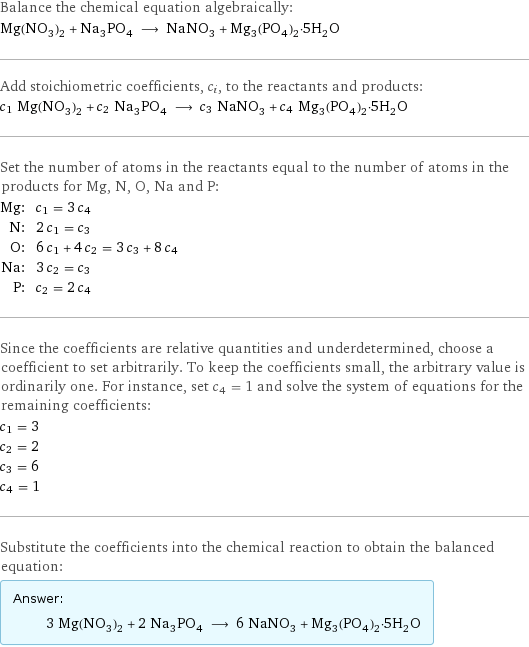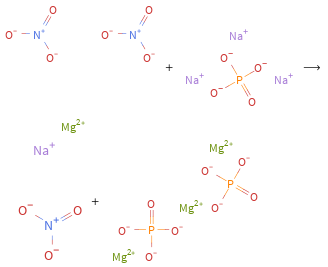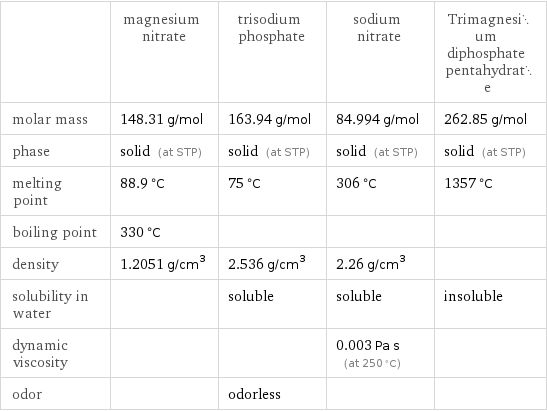Input interpretation

Mg(NO_3)_2 magnesium nitrate + Na_3PO_4 trisodium phosphate ⟶ NaNO_3 sodium nitrate + Mg_3(PO_4)_2·5H_2O Trimagnesium diphosphate pentahydrate
Balanced equation

Balance the chemical equation algebraically: Mg(NO_3)_2 + Na_3PO_4 ⟶ NaNO_3 + Mg_3(PO_4)_2·5H_2O Add stoichiometric coefficients, c_i, to the reactants and products: c_1 Mg(NO_3)_2 + c_2 Na_3PO_4 ⟶ c_3 NaNO_3 + c_4 Mg_3(PO_4)_2·5H_2O Set the number of atoms in the reactants equal to the number of atoms in the products for Mg, N, O, Na and P: Mg: | c_1 = 3 c_4 N: | 2 c_1 = c_3 O: | 6 c_1 + 4 c_2 = 3 c_3 + 8 c_4 Na: | 3 c_2 = c_3 P: | c_2 = 2 c_4 Since the coefficients are relative quantities and underdetermined, choose a coefficient to set arbitrarily. To keep the coefficients small, the arbitrary value is ordinarily one. For instance, set c_4 = 1 and solve the system of equations for the remaining coefficients: c_1 = 3 c_2 = 2 c_3 = 6 c_4 = 1 Substitute the coefficients into the chemical reaction to obtain the balanced equation: Answer: | | 3 Mg(NO_3)_2 + 2 Na_3PO_4 ⟶ 6 NaNO_3 + Mg_3(PO_4)_2·5H_2O
Structures

+ ⟶ +
Names

magnesium nitrate + trisodium phosphate ⟶ sodium nitrate + Trimagnesium diphosphate pentahydrate
Equilibrium constant
![Construct the equilibrium constant, K, expression for: Mg(NO_3)_2 + Na_3PO_4 ⟶ NaNO_3 + Mg_3(PO_4)_2·5H_2O Plan: • Balance the chemical equation. • Determine the stoichiometric numbers. • Assemble the activity expression for each chemical species. • Use the activity expressions to build the equilibrium constant expression. Write the balanced chemical equation: 3 Mg(NO_3)_2 + 2 Na_3PO_4 ⟶ 6 NaNO_3 + Mg_3(PO_4)_2·5H_2O Assign stoichiometric numbers, ν_i, using the stoichiometric coefficients, c_i, from the balanced chemical equation in the following manner: ν_i = -c_i for reactants and ν_i = c_i for products: chemical species | c_i | ν_i Mg(NO_3)_2 | 3 | -3 Na_3PO_4 | 2 | -2 NaNO_3 | 6 | 6 Mg_3(PO_4)_2·5H_2O | 1 | 1 Assemble the activity expressions accounting for the state of matter and ν_i: chemical species | c_i | ν_i | activity expression Mg(NO_3)_2 | 3 | -3 | ([Mg(NO3)2])^(-3) Na_3PO_4 | 2 | -2 | ([Na3PO4])^(-2) NaNO_3 | 6 | 6 | ([NaNO3])^6 Mg_3(PO_4)_2·5H_2O | 1 | 1 | [Mg3(PO4)2·5H2O] The equilibrium constant symbol in the concentration basis is: K_c Mulitply the activity expressions to arrive at the K_c expression: Answer: | | K_c = ([Mg(NO3)2])^(-3) ([Na3PO4])^(-2) ([NaNO3])^6 [Mg3(PO4)2·5H2O] = (([NaNO3])^6 [Mg3(PO4)2·5H2O])/(([Mg(NO3)2])^3 ([Na3PO4])^2)](../image_source/9565618b4cd00ef261e5228af6496fcc.png)
Construct the equilibrium constant, K, expression for: Mg(NO_3)_2 + Na_3PO_4 ⟶ NaNO_3 + Mg_3(PO_4)_2·5H_2O Plan: • Balance the chemical equation. • Determine the stoichiometric numbers. • Assemble the activity expression for each chemical species. • Use the activity expressions to build the equilibrium constant expression. Write the balanced chemical equation: 3 Mg(NO_3)_2 + 2 Na_3PO_4 ⟶ 6 NaNO_3 + Mg_3(PO_4)_2·5H_2O Assign stoichiometric numbers, ν_i, using the stoichiometric coefficients, c_i, from the balanced chemical equation in the following manner: ν_i = -c_i for reactants and ν_i = c_i for products: chemical species | c_i | ν_i Mg(NO_3)_2 | 3 | -3 Na_3PO_4 | 2 | -2 NaNO_3 | 6 | 6 Mg_3(PO_4)_2·5H_2O | 1 | 1 Assemble the activity expressions accounting for the state of matter and ν_i: chemical species | c_i | ν_i | activity expression Mg(NO_3)_2 | 3 | -3 | ([Mg(NO3)2])^(-3) Na_3PO_4 | 2 | -2 | ([Na3PO4])^(-2) NaNO_3 | 6 | 6 | ([NaNO3])^6 Mg_3(PO_4)_2·5H_2O | 1 | 1 | [Mg3(PO4)2·5H2O] The equilibrium constant symbol in the concentration basis is: K_c Mulitply the activity expressions to arrive at the K_c expression: Answer: | | K_c = ([Mg(NO3)2])^(-3) ([Na3PO4])^(-2) ([NaNO3])^6 [Mg3(PO4)2·5H2O] = (([NaNO3])^6 [Mg3(PO4)2·5H2O])/(([Mg(NO3)2])^3 ([Na3PO4])^2)
Rate of reaction
![Construct the rate of reaction expression for: Mg(NO_3)_2 + Na_3PO_4 ⟶ NaNO_3 + Mg_3(PO_4)_2·5H_2O Plan: • Balance the chemical equation. • Determine the stoichiometric numbers. • Assemble the rate term for each chemical species. • Write the rate of reaction expression. Write the balanced chemical equation: 3 Mg(NO_3)_2 + 2 Na_3PO_4 ⟶ 6 NaNO_3 + Mg_3(PO_4)_2·5H_2O Assign stoichiometric numbers, ν_i, using the stoichiometric coefficients, c_i, from the balanced chemical equation in the following manner: ν_i = -c_i for reactants and ν_i = c_i for products: chemical species | c_i | ν_i Mg(NO_3)_2 | 3 | -3 Na_3PO_4 | 2 | -2 NaNO_3 | 6 | 6 Mg_3(PO_4)_2·5H_2O | 1 | 1 The rate term for each chemical species, B_i, is 1/ν_i(Δ[B_i])/(Δt) where [B_i] is the amount concentration and t is time: chemical species | c_i | ν_i | rate term Mg(NO_3)_2 | 3 | -3 | -1/3 (Δ[Mg(NO3)2])/(Δt) Na_3PO_4 | 2 | -2 | -1/2 (Δ[Na3PO4])/(Δt) NaNO_3 | 6 | 6 | 1/6 (Δ[NaNO3])/(Δt) Mg_3(PO_4)_2·5H_2O | 1 | 1 | (Δ[Mg3(PO4)2·5H2O])/(Δt) (for infinitesimal rate of change, replace Δ with d) Set the rate terms equal to each other to arrive at the rate expression: Answer: | | rate = -1/3 (Δ[Mg(NO3)2])/(Δt) = -1/2 (Δ[Na3PO4])/(Δt) = 1/6 (Δ[NaNO3])/(Δt) = (Δ[Mg3(PO4)2·5H2O])/(Δt) (assuming constant volume and no accumulation of intermediates or side products)](../image_source/c2c5f0d78c0718fdbf2347dea3a18714.png)
Construct the rate of reaction expression for: Mg(NO_3)_2 + Na_3PO_4 ⟶ NaNO_3 + Mg_3(PO_4)_2·5H_2O Plan: • Balance the chemical equation. • Determine the stoichiometric numbers. • Assemble the rate term for each chemical species. • Write the rate of reaction expression. Write the balanced chemical equation: 3 Mg(NO_3)_2 + 2 Na_3PO_4 ⟶ 6 NaNO_3 + Mg_3(PO_4)_2·5H_2O Assign stoichiometric numbers, ν_i, using the stoichiometric coefficients, c_i, from the balanced chemical equation in the following manner: ν_i = -c_i for reactants and ν_i = c_i for products: chemical species | c_i | ν_i Mg(NO_3)_2 | 3 | -3 Na_3PO_4 | 2 | -2 NaNO_3 | 6 | 6 Mg_3(PO_4)_2·5H_2O | 1 | 1 The rate term for each chemical species, B_i, is 1/ν_i(Δ[B_i])/(Δt) where [B_i] is the amount concentration and t is time: chemical species | c_i | ν_i | rate term Mg(NO_3)_2 | 3 | -3 | -1/3 (Δ[Mg(NO3)2])/(Δt) Na_3PO_4 | 2 | -2 | -1/2 (Δ[Na3PO4])/(Δt) NaNO_3 | 6 | 6 | 1/6 (Δ[NaNO3])/(Δt) Mg_3(PO_4)_2·5H_2O | 1 | 1 | (Δ[Mg3(PO4)2·5H2O])/(Δt) (for infinitesimal rate of change, replace Δ with d) Set the rate terms equal to each other to arrive at the rate expression: Answer: | | rate = -1/3 (Δ[Mg(NO3)2])/(Δt) = -1/2 (Δ[Na3PO4])/(Δt) = 1/6 (Δ[NaNO3])/(Δt) = (Δ[Mg3(PO4)2·5H2O])/(Δt) (assuming constant volume and no accumulation of intermediates or side products)
Chemical names and formulas

| magnesium nitrate | trisodium phosphate | sodium nitrate | Trimagnesium diphosphate pentahydrate formula | Mg(NO_3)_2 | Na_3PO_4 | NaNO_3 | Mg_3(PO_4)_2·5H_2O Hill formula | MgN_2O_6 | Na_3O_4P | NNaO_3 | Mg_3O_8P_2 name | magnesium nitrate | trisodium phosphate | sodium nitrate | Trimagnesium diphosphate pentahydrate IUPAC name | magnesium dinitrate | trisodium phosphate | sodium nitrate | trimagnesium diphosphate
Substance properties

| magnesium nitrate | trisodium phosphate | sodium nitrate | Trimagnesium diphosphate pentahydrate molar mass | 148.31 g/mol | 163.94 g/mol | 84.994 g/mol | 262.85 g/mol phase | solid (at STP) | solid (at STP) | solid (at STP) | solid (at STP) melting point | 88.9 °C | 75 °C | 306 °C | 1357 °C boiling point | 330 °C | | | density | 1.2051 g/cm^3 | 2.536 g/cm^3 | 2.26 g/cm^3 | solubility in water | | soluble | soluble | insoluble dynamic viscosity | | | 0.003 Pa s (at 250 °C) | odor | | odorless | |
Units
